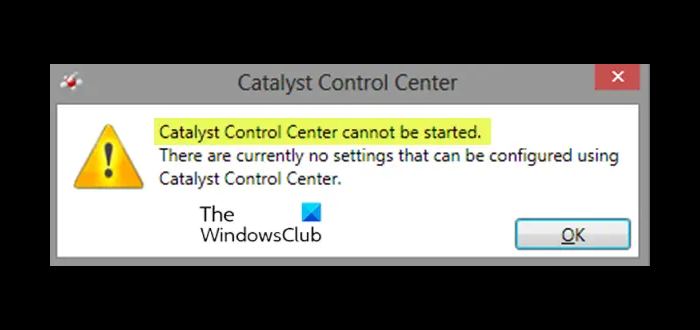If when you try to open the AMD Catalyst Control Center you receive the error message Catalyst Control Center cannot be started, then this post is intended to help you. In this post, we will identify the possible causes, as well as provide the corresponding solutions you can try to remediate this issue.

When you encounter this issue, you’ll receive the following full error message;
Catalyst Control Center cannot be started.
There are currently no settings that can be configured using Catalyst Control Center.
When this error occurs, you won’t be able to open the Catalyst Control Center and, therefore, make any changes in the settings.
This issue is usually related to driver problems. Either the driver files are corrupt, or a compatibility issue is causing this problem.
AMD Catalyst Control Center cannot be started
AMD Catalyst Control Center (formerly named ATI Catalyst Control Center) is a device driver and utility software package for ATI/AMD line of video cards.
If you’re faced with this Catalyst Control Center cannot be started issue on your AMD-based Windows PC, you can try our recommended solutions in the order presented below to resolve the issue.
- Install the ccc2_install file
- Uninstall and Reinstall Graphics drivers
- Clean install the Graphics drivers
Let’s take a look at the description of the process involved concerning each of the listed solutions.
1] Install the ccc2_install file
This solution requires you to run a file named ccc2_install in the AMD folder. It has been known that once you run this file, the Catalyst Control Center cannot be started issue will be resolved.
Here’s how:
- Press Windows key + R to invoke the Run dialog.
- In the Run dialog box, copy and paste the file/directory path below and hit Enter.
C:\Program Files\AMD\CCC2\Install
- At the location, there should be a ccc2_install application file.
- Right-click the file and select Run as administrator.
After running the file the issue should be resolved. If not, continue with the next solution.
2] Uninstall and Reinstall Graphics drivers
Since the problem is caused by drivers, this solution requires you to simply uninstall and reinstall the graphics drivers.
Note: You need to install both Intel and AMD drivers only if you have an Intel/AMD setup. If you have an AMD processor then you don’t have to download and install the Intel drivers. Keep in mind that you need to install the Intel drivers before installing the AMD drivers.
Also, before installing the drivers, ensure your anti-virus application is disabled. Third-party security applications are known to cause issues with the installation process. Once you have the AV program disabled from the system tray/notification area on the right of the Taskbar, you can continue as follows.
PC users who have an Intel processor and AMD graphics, do the following:
- Temporarily disable Windows Update from Services.
Disabling Windows Update will prevent Windows from automatically updating the drivers.
If you’re not sure which Intel Graphics is installed on your device, you can run dxdiag to find out.
- Now that you have the latest Intel drivers installed, you can proceed to uninstall the AMD drivers/software via the Programs and Features applet.
- Once you have done that, invoke the Run dialog, and type the file/directory path below and hit Enter.
C:\AMD
- At the location, press CTRL + A to select the contents and then tap DELETE on your keyboard.
- Now, download and install the latest version of AMD drivers.
- Reboot your PC once the AMD drivers are installed.
PC users who have AMD processor and AMD graphics, do the following:
If you have an AMD processors/APU’s then you don’t have to download the Intel graphics drivers. The AMD drivers from their official website will be enough for you.
So, repeat the steps as described above for uninstalling and reinstalling the AMD drivers/software but before you do, temporarily disable the Windows Update via Services.
After completing the procedure and restarting your computer, the Catalyst Control Center cannot be started issue should be resolved. Else, continue with the next solution.
3] Clean install the Graphics drivers
If Solution 2 above didn’t work for you then you might have to perform a clean install of the Graphics drivers.
Note: If you have Intel Graphics and AMD graphics as well then make sure you update the Intel Graphics before installing the AMD graphics. See the PC users who have an Intel processor and AMD graphics section in Solution 2 (if you haven’t already) and follow the steps.
Also, before installing the drivers, ensure your anti-virus application is disabled. These 3rd-party security applications are known to cause some issues with the installation process. Once you have the AV program disabled from the system tray/notification area on the right of the Taskbar, you can now continue as follows:
This utility clears up the previous graphic drivers and their leftover files. This is useful because it ensures the newer driver is installed properly. Most of the time, your new driver won’t be installed properly because of the previous version, which is conflicting with leftover files.
- Once done, download the AMD latest drivers as described in Solution 2 above.
- Next, clear the contents of the C:\AMD directory as shown in Solution 2.
- Next, temporarily disable Windows Update from Services.
- Next, uninstall the AMD drivers/software via the Programs and Features applet.
- Now, you’ll need to boot into Safe Mode to run the Display Driver Uninstaller.
- After the Display Driver Uninstaller completes its job, you can now install the AMD drivers you downloaded.
Once the drivers are installed, restart your PC normally. On boot, you should have a clean install of the drivers and the Catalyst Control Center cannot be started issue should be resolved.
Leave a Reply